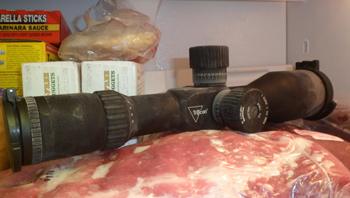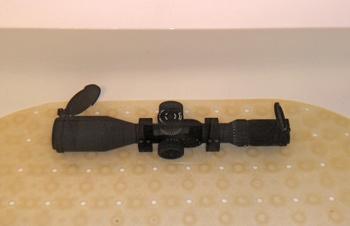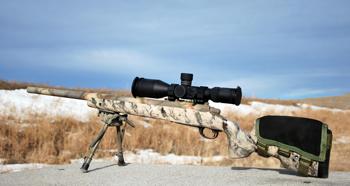Trijicon Tactical Advanced Riflescope (TARS) Review
Trijicon Tactical Advanced Riflescope (TARS) Review
By Nicholas Gebhardt
Page 3
Trijicon is famous for providing reticle illumination without the use of battery power but have deviated from this technique for the TARS. Reticle illumination is provided through a single CR2032 battery power source and is accomplished with an LED providing industry leading "diffraction grating technology." A total of ten illumination settings are available with the lowest three levels appropriate for night vision use. Adjustment of illumination intensity is through a digital push button interface on the left side of the scope just aft of the parallax adjustment turret. Only the very center of the reticle is illuminated and is simply turned on by pressing either the + or - button. Illumination is turned off by pressing both buttons and holding them for three seconds.
SCOPE TESTING
My testing of this scope began in the kitchen, with the scope being frozen for a period of time. The scope was placed in the freezer on top of a rack of baby back ribs while I waited for the rings to show up from Seekins Precision. Total amount of time in the freezer was about 21 hours after which I removed the scope to check for function of all adjustments. The elevation, windage, and parallax turrets turned with about the same amount of resistance prior to freezing and there was no binding of the turret lock mechanisms. The scope retained its internal integrity as there wasn't any internal fogging after being removed from the freezer. The only problem with the scope after being frozen was with the magnification adjustment, which was effectively frozen in place between 3X and 4X, which I thought to be disconcerting given that the scope was designed for extreme military duty. The magnification ring remained frozen for 38 minutes after the scope was removed. This is when I noticed something strange. The magnification ring would turn between the 3X and 4X, but wouldn't move past the 4X marking. As I continued to try to get it to move, the magnification ring finally freed and would turn through the entire adjustment range. Being that the scope was back to working order, I wanted to see if this was a one-time incident or if it would repeat after being frozen again. Back in the freezer it went for a second trial which produced the same results. According to my Kestrel weather meter, my freezer temperature was right at 32 F.

TARS chilling with some baby back ribs
Placing a scope in a freezer doesn't sound like much of a test at first. But considering that I have often found myself on hunting trips for either big game or while pursuing coyotes at temperatures close to the 0o F temperature range, I feel this is a valid method of testing a scope while in the home environment. I'm also well aware of military operators that train in arctic conditions and having a scopes magnification ring freeze up rendering it inoperable is unacceptable. I sent an email to my contact at Trijicon that next morning informing them of the issue I noticed. I am happy to report that Trijicon is well aware of the issue, it has been corrected, and the problem is limited to the very first scopes that were produced. The problem was immediately corrected with the design and there are no further issues with the scopes when operating in sub-freezing conditions.
The next test I routinely conduct on my optics is to immerse them in water for a minimum of one hour. The TARS received the same treatment as it should be more than capable of withstanding a bathtub of cold water. I placed the scope in the tub and only filled it with enough cold water to completely submerge the scope. I didn't immediately notice any air bubbles coming up from the scope which was a good sign. I use cold water for this portion of the test as I don't believe any military operators, nor anybody else for that matter, encounter Jacuzzi temperature waters while pursuing their adversaries or game animals. After two hours of being submerged, the scope was removed and checked for internal water as well as function of all other controls. There was no internal leakage of water and all controls including the reticle illumination worked without trouble. This scope is sealed up tight.

TARS taking a tactical soak
In order to check the optics on this scope I ordered a resolving power chart from Edmund Optics. This chart is not a simple sheet of printer paper with various colored schemes printed on it, but a 2'X3' heavy weight paper with the USAF diagram to check for chromatic aberration as well as other optical qualities. This chart was stapled to a poly backing material for stiffness and then placed at 100 yards to evaluate the optical characteristics of the TARS. Testing took place on a calm day in central Montana and the skies had scattered clouds. I also had a Steiner 3-15X50 Military available while testing so I compared the two scopes for optical performance and characteristics.

At the range
By Nicholas Gebhardt
Page 3
Trijicon is famous for providing reticle illumination without the use of battery power but have deviated from this technique for the TARS. Reticle illumination is provided through a single CR2032 battery power source and is accomplished with an LED providing industry leading "diffraction grating technology." A total of ten illumination settings are available with the lowest three levels appropriate for night vision use. Adjustment of illumination intensity is through a digital push button interface on the left side of the scope just aft of the parallax adjustment turret. Only the very center of the reticle is illuminated and is simply turned on by pressing either the + or - button. Illumination is turned off by pressing both buttons and holding them for three seconds.
SCOPE TESTING
My testing of this scope began in the kitchen, with the scope being frozen for a period of time. The scope was placed in the freezer on top of a rack of baby back ribs while I waited for the rings to show up from Seekins Precision. Total amount of time in the freezer was about 21 hours after which I removed the scope to check for function of all adjustments. The elevation, windage, and parallax turrets turned with about the same amount of resistance prior to freezing and there was no binding of the turret lock mechanisms. The scope retained its internal integrity as there wasn't any internal fogging after being removed from the freezer. The only problem with the scope after being frozen was with the magnification adjustment, which was effectively frozen in place between 3X and 4X, which I thought to be disconcerting given that the scope was designed for extreme military duty. The magnification ring remained frozen for 38 minutes after the scope was removed. This is when I noticed something strange. The magnification ring would turn between the 3X and 4X, but wouldn't move past the 4X marking. As I continued to try to get it to move, the magnification ring finally freed and would turn through the entire adjustment range. Being that the scope was back to working order, I wanted to see if this was a one-time incident or if it would repeat after being frozen again. Back in the freezer it went for a second trial which produced the same results. According to my Kestrel weather meter, my freezer temperature was right at 32 F.
TARS chilling with some baby back ribs
Placing a scope in a freezer doesn't sound like much of a test at first. But considering that I have often found myself on hunting trips for either big game or while pursuing coyotes at temperatures close to the 0o F temperature range, I feel this is a valid method of testing a scope while in the home environment. I'm also well aware of military operators that train in arctic conditions and having a scopes magnification ring freeze up rendering it inoperable is unacceptable. I sent an email to my contact at Trijicon that next morning informing them of the issue I noticed. I am happy to report that Trijicon is well aware of the issue, it has been corrected, and the problem is limited to the very first scopes that were produced. The problem was immediately corrected with the design and there are no further issues with the scopes when operating in sub-freezing conditions.
The next test I routinely conduct on my optics is to immerse them in water for a minimum of one hour. The TARS received the same treatment as it should be more than capable of withstanding a bathtub of cold water. I placed the scope in the tub and only filled it with enough cold water to completely submerge the scope. I didn't immediately notice any air bubbles coming up from the scope which was a good sign. I use cold water for this portion of the test as I don't believe any military operators, nor anybody else for that matter, encounter Jacuzzi temperature waters while pursuing their adversaries or game animals. After two hours of being submerged, the scope was removed and checked for internal water as well as function of all other controls. There was no internal leakage of water and all controls including the reticle illumination worked without trouble. This scope is sealed up tight.
TARS taking a tactical soak
In order to check the optics on this scope I ordered a resolving power chart from Edmund Optics. This chart is not a simple sheet of printer paper with various colored schemes printed on it, but a 2'X3' heavy weight paper with the USAF diagram to check for chromatic aberration as well as other optical qualities. This chart was stapled to a poly backing material for stiffness and then placed at 100 yards to evaluate the optical characteristics of the TARS. Testing took place on a calm day in central Montana and the skies had scattered clouds. I also had a Steiner 3-15X50 Military available while testing so I compared the two scopes for optical performance and characteristics.
At the range
